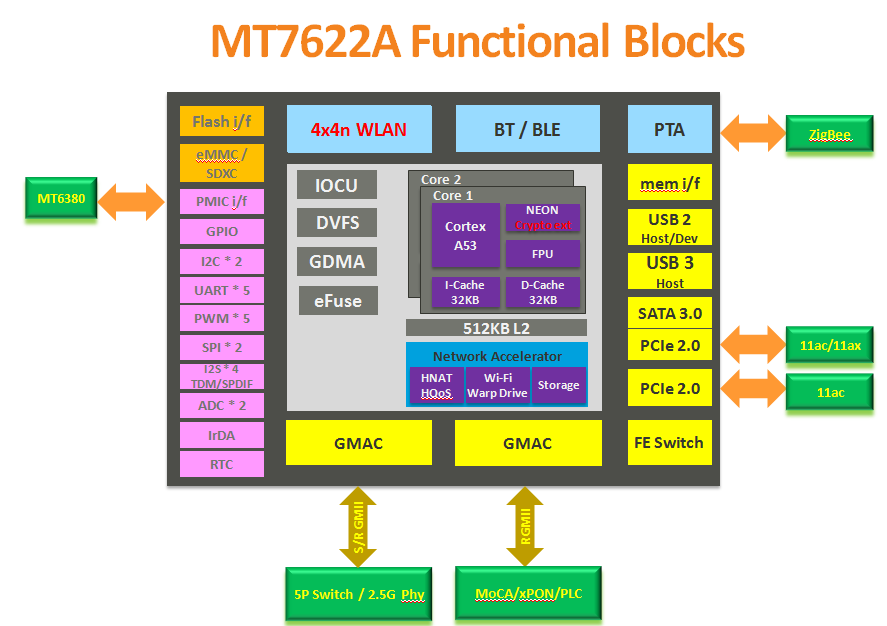MediaTek has launched a new ARM SoC for routers, home automation gateways, wireless audio and storage, with MT7622 equipped with a dual core ARM Cortex A53 processor, a dedicated network accelerator, 4×4 802.11n and Bluetooth 5 connectivity. Two models with be available: MT7622A with all features, and MT7622B with router features only, which probably mean no Bluetooth, and possibly less I/Os.
 MediaTek MT7622 specifications:
MediaTek MT7622 specifications:
- Processor – Dual core ARM Cortex A53 @ up to 1.36 GHz
- Storage – eMMC and SDXC interfaces; storage accelerator (SATA 3.0/eSATA Gen2)
- Connectivity
- 802.11b/g/n WiFi @ 2.4GHz, 4T4R antenna; 802.11ac can be added through MT7615 SoC
- Bluetooth 5
- Fast Ethernet Switch, RGMII and SGMII
- Network Accelerator – APT+HQoS, MediaTek Wi-Fi Warp Accelerator
- Audio – Audio Amplifier, I2S, TDM, S/PDIF
- USB – USB 2.0 host/device, USB 3.0 host
- Other Peripheral Interfaces – PCIe Gen 2.0, ADC, GPIO, I2C, IR, PMIC I/F, PWM, SPI, UART
- Misc – RTC
The specs on the product page are currently all over the place, with “Zigbee” also dropped somewhere in the text, but not in the specifications list, nor is Bluetooth 5. They also wrote Bluetooth 5.0 instead of Bluetooth 5, but it’s a minor issue. They however provide some more details about the WiFi Warp accelerator:
Firstly it connects the Gigabit+ class 802.11ac networking through to the Gigabit switch/WAN connection via multi-Gigabit internal pathways, ensuring no bottleneck. Secondly, its specialized design not only offloads the CPU from many-user throughput and QoS calculations, it does so at lower power. The result is the MediaTek Wi-Fi Warp Accelerator maintains a sustained high-performance when even supporting multiple, simultaneous heavy users.
Another good news is that MediaTek engineers have started to contribute MT7622 related code to mainline Linux.


Jean-Luc started CNX Software in 2010 as a part-time endeavor, before quitting his job as a software engineering manager, and starting to write daily news, and reviews full time later in 2011.
Support CNX Software! Donate via cryptocurrencies, become a Patron on Patreon, or purchase goods on Amazon or Aliexpress




